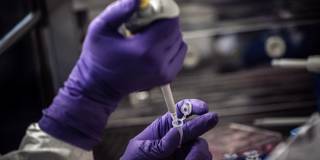Just as a meager investment to address antimicrobial resistance could yield a 2,000% return in the future, so, too, would an immediate modest outlay to finance development of COVID-19 therapeutics. As world leaders gather to formulate a response to the crisis, they must not lose sight of this simple cost-benefit calculus.
LONDON – This week, G20 leaders will convene virtually to discuss the COVID-19 crisis. One hopes that the emergency summit marks the beginning of a thoughtful collective response to this grave challenge. If so, the meeting may turn out to be even more consequential than the London summit hosted by British Prime Minister Gordon Brown in April 2009, which created the framework for a coordinated multilateral response to the global financial crisis.
Having chaired the United Kingdom’s global Review on Antimicrobial Resistance (AMR), I cannot help but think that the current crisis demands a similar undertaking to bring together infectious-disease modeling, economic analysis, and evidence-based solutions. When our findings were published in 2016, we garnered a good deal of attention for highlighting both the potential loss of life and the economic costs of inaction in the face of AMR. By 2050, we warned, antibiotic-resistant microbes could take up to ten million lives per year, at a total cost of around $100 trillion in lost output between 2015 and 2050.
But we also showed that these horrendous outcomes could be prevented with a relatively meager investment of $42 billion, implying a return of around 2,000%. Now that the COVID-19 pandemic has rapidly accelerated the use of disinfectants, I shudder to think of a future in which we still have not taken the necessary steps to manage biological threats. If we run out of useful antibiotics, the time it will take to develop new ones will far exceed that expected for developing a COVID-19 vaccine.

LONDON – This week, G20 leaders will convene virtually to discuss the COVID-19 crisis. One hopes that the emergency summit marks the beginning of a thoughtful collective response to this grave challenge. If so, the meeting may turn out to be even more consequential than the London summit hosted by British Prime Minister Gordon Brown in April 2009, which created the framework for a coordinated multilateral response to the global financial crisis.
Having chaired the United Kingdom’s global Review on Antimicrobial Resistance (AMR), I cannot help but think that the current crisis demands a similar undertaking to bring together infectious-disease modeling, economic analysis, and evidence-based solutions. When our findings were published in 2016, we garnered a good deal of attention for highlighting both the potential loss of life and the economic costs of inaction in the face of AMR. By 2050, we warned, antibiotic-resistant microbes could take up to ten million lives per year, at a total cost of around $100 trillion in lost output between 2015 and 2050.
But we also showed that these horrendous outcomes could be prevented with a relatively meager investment of $42 billion, implying a return of around 2,000%. Now that the COVID-19 pandemic has rapidly accelerated the use of disinfectants, I shudder to think of a future in which we still have not taken the necessary steps to manage biological threats. If we run out of useful antibiotics, the time it will take to develop new ones will far exceed that expected for developing a COVID-19 vaccine.